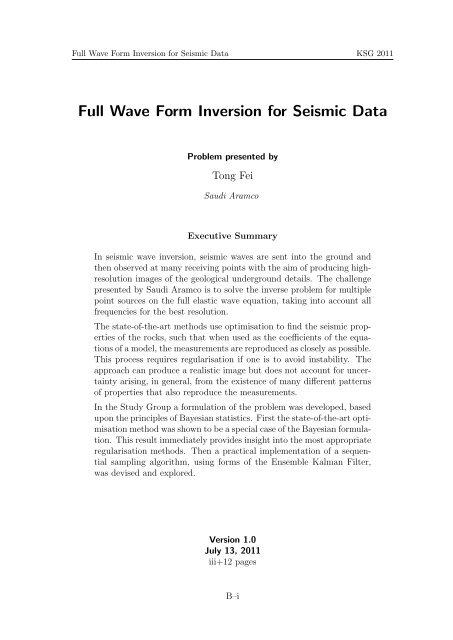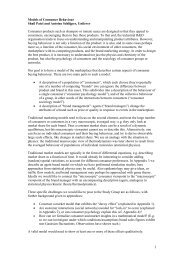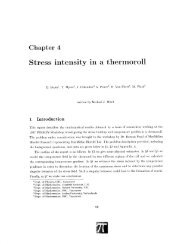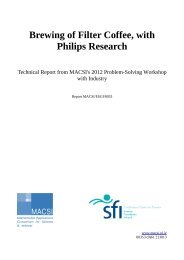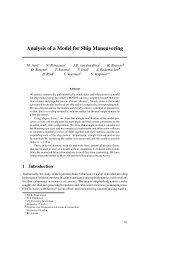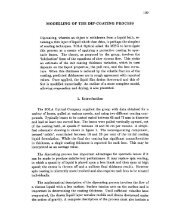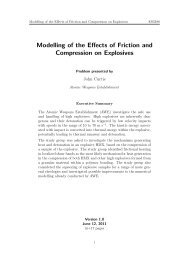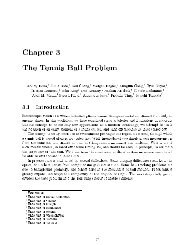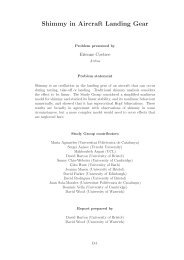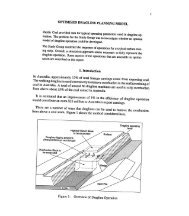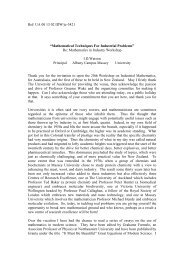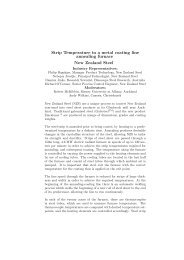Full Wave Form Inversion for Seismic Data
Full Wave Form Inversion for Seismic Data
Full Wave Form Inversion for Seismic Data
You also want an ePaper? Increase the reach of your titles
YUMPU automatically turns print PDFs into web optimized ePapers that Google loves.
<strong>Full</strong> <strong>Wave</strong> <strong>Form</strong> <strong>Inversion</strong> <strong>for</strong> <strong>Seismic</strong> <strong>Data</strong> KSG 2011<br />
<strong>Full</strong> <strong>Wave</strong> <strong>Form</strong> <strong>Inversion</strong> <strong>for</strong> <strong>Seismic</strong> <strong>Data</strong><br />
Problem presented by<br />
Tong Fei<br />
Saudi Aramco<br />
Executive Summary<br />
In seismic wave inversion, seismic waves are sent into the ground and<br />
then observed at many receiving points with the aim of producing highresolution<br />
images of the geological underground details. The challenge<br />
presented by Saudi Aramco is to solve the inverse problem <strong>for</strong> multiple<br />
point sources on the full elastic wave equation, taking into account all<br />
frequencies <strong>for</strong> the best resolution.<br />
The state-of-the-art methods use optimisation to find the seismic properties<br />
of the rocks, such that when used as the coefficients of the equations<br />
of a model, the measurements are reproduced as closely as possible.<br />
This process requires regularisation if one is to avoid instability. The<br />
approach can produce a realistic image but does not account <strong>for</strong> uncertainty<br />
arising, in general, from the existence of many different patterns<br />
of properties that also reproduce the measurements.<br />
In the Study Group a <strong>for</strong>mulation of the problem was developed, based<br />
upon the principles of Bayesian statistics. First the state-of-the-art optimisation<br />
method was shown to be a special case of the Bayesian <strong>for</strong>mulation.<br />
This result immediately provides insight into the most appropriate<br />
regularisation methods. Then a practical implementation of a sequential<br />
sampling algorithm, using <strong>for</strong>ms of the Ensemble Kalman Filter,<br />
was devised and explored.<br />
Version 1.0<br />
July 13, 2011<br />
iii+12 pages<br />
B–i
<strong>Full</strong> <strong>Wave</strong> <strong>Form</strong> <strong>Inversion</strong> <strong>for</strong> <strong>Seismic</strong> <strong>Data</strong> KSG 2011<br />
Report coordinator<br />
C. Farmer, I. Hoteit, X. Luo, C. Boonyasiriwat and T. Alkhalifah<br />
Contributors<br />
Tariq Alkhalifah (KAUST, Saudi Arabia)<br />
Mohammed Alsunaidi (KFUPM, Saudi Arabia)<br />
Chaiwoot Boonyasiriwat (KAUST, Saudi Arabia)<br />
Nadia Chouaieb (KAUST, Saudi Arabia)<br />
R. Djebbi (KAUST, Saudi Arabia)<br />
Shouhong Du (KAUST, Saudi Arabia)<br />
Chris Farmer (OCCAM, UK)<br />
Nicholas Hale (OCCAM, UK)<br />
Ibrahim Hoteit (KAUST, Saudi Arabia)<br />
Taous-Meriem Laleg-Kirati (KAUST, Saudi Arabia)<br />
Chong Luo (OCCAM, UK)<br />
Xiaodong Luo (KAUST, Saudi Arabia)<br />
Alvaro Moraes (KAUST, Saudi Arabia)<br />
Surya Pachhai (KAUST, Saudi Arabia)<br />
Pedro Vilanova (KAUST, Saudi Arabia)<br />
Babar Hasan Khan (KAUST, Saudi Arabia)<br />
Pedro Guerra (KAUST, Saudi Arabia)<br />
Abdulrahman Al-shuhail (KAUST, Saudi Arabia)<br />
Mohamad Elgharamti (KAUST, Saudi Arabia)<br />
KSG 2011 was organised by<br />
King Abdullah University of Science and Technology (KAUST)<br />
In collaboration with<br />
Ox<strong>for</strong>d Centre <strong>for</strong> Collaborative Applied Mathematics (OCCAM)<br />
B–ii
<strong>Full</strong> <strong>Wave</strong> <strong>Form</strong> <strong>Inversion</strong> <strong>for</strong> <strong>Seismic</strong> <strong>Data</strong> KSG 2011<br />
Contents<br />
1 Introduction 1<br />
2 Forward Problem 3<br />
2.1 Continuum <strong>for</strong>ward model . . . . . . . . . . . . . . . . . . . . . . . 3<br />
2.2 Discrete <strong>for</strong>ward model . . . . . . . . . . . . . . . . . . . . . . . . . 4<br />
3 Minimum Misfit <strong>Form</strong>ulation of the Inverse Problem 5<br />
4 Inverse Problems from the Statistical Viewpoint 6<br />
4.1 The Sequential Bayesian Filtering Equations . . . . . . . . . . . . . 6<br />
4.2 The Bayesian Smoothing Equation . . . . . . . . . . . . . . . . . . 7<br />
5 Practical Methods <strong>for</strong> Implementing a Bayesian Filter 8<br />
6 Conclusions 10<br />
Bibliography 11<br />
B–iii
<strong>Full</strong> <strong>Wave</strong> <strong>Form</strong> <strong>Inversion</strong> <strong>for</strong> <strong>Seismic</strong> <strong>Data</strong> KSG 2011<br />
1 Introduction<br />
Saudi Aramco is an oil company responsible <strong>for</strong> the discovery and recovery of hydrocarbons<br />
from geological <strong>for</strong>mations. The principal method <strong>for</strong> the exploration<br />
of oil is the seismic survey.<br />
<strong>Seismic</strong> acquisition involves sending acoustic energy into the subsurface and<br />
analysing the echoes. This is an inverse problem on the acoustic or even the full<br />
elastic wave equation. <strong>Data</strong> are gathered from many independent experiments, as a<br />
sound source is activated in a sequence of shots as it is moved over the land or sea<br />
surface. The results are preprocessed using a wide range of techniques designed to<br />
correct <strong>for</strong> topographical features and noise. A complete review of these techniques<br />
can be found in [12].<br />
Figure 1: A schematic cross-section of a complex geological pattern and a seismic shot.<br />
After preprocessing, and in a traditional workflow, the main inversion step is<br />
known as migration. The amount of data, and the size of the system under investigation<br />
are both very large. Until recently this precluded the use of simple<br />
numerical techniques <strong>for</strong> solving the <strong>for</strong>ward model, as used <strong>for</strong> example <strong>for</strong> the<br />
fluid flow <strong>for</strong>ward problem when per<strong>for</strong>ming oil reservoir simulation. Instead a<br />
range of semi-analytical approximations are used in routine applications. The approximations<br />
vary in accuracy, complexity and applicability. The simplest methods<br />
are known as time migration, using the Born approximation obtained from linearisation<br />
about a simple background spatial distribution of elastic properties. The Born<br />
approximation is solved using Fourier methods. For a detailed explanation of the<br />
mathematical theory see [2]. In recent years more sophisticated and more accurate<br />
methods known as depth migration based on high-frequency ray-tracing methods<br />
have been developed. However, with the continuing rapid increases in computing<br />
resources, it is now becoming possible to use full finite difference or pseudo-spectral<br />
approximations. The resolution requirements are very demanding and it can take<br />
many millions of computing hours to obtain a single inversion, but the prospects<br />
that full inversion provides make this a valuable topic <strong>for</strong> further research.<br />
B–1
<strong>Full</strong> <strong>Wave</strong> <strong>Form</strong> <strong>Inversion</strong> <strong>for</strong> <strong>Seismic</strong> <strong>Data</strong> KSG 2011<br />
The results are usually presented in the time domain which, to a first approximation,<br />
removes the effects of any layer cake background model. Users of the inverted<br />
results are able to apply their own time-to-depth conversions as more data becomes<br />
available, or as the seismic data is combined with other data. The time-to-depth<br />
conversion is per<strong>for</strong>med using alternative layer cake models of the sound speed and<br />
rock density. Note that depth processed seismic results using depth migration are<br />
often displayed in the time domain by applying a depth-to-time conversion.<br />
After migration, and display in the time domain, the observations are equivalent<br />
to a numerical experiment that measures the response that would be observed in<br />
an ideal experiment where the sound waves are assumed to propagate in vertical,<br />
straight lines, and that any reflectors that are encountered are locally horizontal.<br />
The resulting calculations are then displayed as seismograms of the virtual experiment.<br />
At the Study Group, Tong Fei of Saudi Aramco explained how full wave <strong>for</strong>m<br />
inversion (FWI), as the rigorous solution of the inverse problem <strong>for</strong> wave propagation<br />
is known, holds out the prospect of improved quality of the seismic images<br />
enabling the recovery of oil from geological <strong>for</strong>mations with greater reliability than<br />
more traditional approaches.<br />
The FWI method currently used by Saudi Aramco, other oil companies and<br />
many academic researchers is to <strong>for</strong>mulate the inverse problem in the usual ‘minimum<br />
misfit with regularisation’ framework. That is, the solution of the <strong>for</strong>ward<br />
problem is re-cast as an equation that predicts the measurements if the rock properties<br />
were known. The properties are then adjusted until the predicted measurements<br />
match the actual measurements. Such a process is generally ill-posed in that<br />
there are many geometric arrangements of properties that provide a good match<br />
(although very hard to compute) and further a small change in the values of the<br />
measurements or the details of the <strong>for</strong>ward model can give rise to a large change in<br />
the properties that provide the match. For this reason additional terms have to be<br />
added to the misfit function to remove the instability. However, such a process does<br />
not remove the non-uniqueness. Saudi Aramco were using the method of first order<br />
Tikhonov regularisation which stabilises the misfit function by adding a weighted<br />
sum of squares of the physical properties as averaged over a grid cell.<br />
In the Study Group the discussion turned to the application of statistical ideas<br />
to the inverse problem. The academic participants first of all explained how to<br />
interpret the Tikhonov approach as the negative logarithm of a prior probability<br />
density function representing the prior geological knowledge. Then they worked on<br />
ways of reducing the complexity of the Bayesian approach so that the uncertainty<br />
could be properly quantified and calculations representing the full posterior density<br />
function could be per<strong>for</strong>med with a level of computation similar to that of the less<br />
complete deterministic regularised minimum misfit approach.<br />
The Study Group per<strong>for</strong>med some simple numerical experiments which appeared<br />
to indicate that progress might be possible. However, the problem is exceedingly<br />
difficult and so the group concentrated on the <strong>for</strong>mulation of the problem and the<br />
groundwork needed <strong>for</strong> others to make a later proposal <strong>for</strong> further research.<br />
The following report outlines the background knowledge required to understand<br />
B–2
<strong>Full</strong> <strong>Wave</strong> <strong>Form</strong> <strong>Inversion</strong> <strong>for</strong> <strong>Seismic</strong> <strong>Data</strong> KSG 2011<br />
where s is the source term and c p is the speed of ‘P-waves’ such that c p = (λ+2µ)/ρ.<br />
By taking the curl of the Navier equations one obtains a linear wave equation<br />
<strong>for</strong> a vector field of shear waves, called ‘S-waves’, that travel with a local speed of<br />
c s = µ/ρ. Generally the P-waves travel at a faster speed than the S-waves and<br />
in many approaches to seismic exploration theory it is only the P-waves that are<br />
modelled. However, in more recent literature there is a growing interest in using<br />
the full Navier equation or even the full elasto-dynamic equations with only some<br />
assumptions of material symmetry appropriate, <strong>for</strong> example, <strong>for</strong> a layered material.<br />
2.2 Discrete <strong>for</strong>ward model<br />
The standard and most straight<strong>for</strong>ward method <strong>for</strong> solving the various wave equations<br />
is to use a finite difference method. Saudi Aramco have been using very<br />
high order methods, as high as 12-th or 14-th order. We will not describe the details<br />
of this, as this was not discussed during the Study Group and is not key to<br />
understanding the inverse problem.<br />
Let us suppose that time is discretised into discrete times t n , with n = 0, 1, ...<br />
and such that the response is observed at each t n and the shots occur at sporadic<br />
times, with many time steps in between. When solving the discretised wave equation<br />
there might well be many subsidiary time steps, <strong>for</strong> reasons of numerical stability or<br />
accuracy, in between the observation times. The measurements themselves might<br />
be averaged or interpolated so that the model discrete time, the observation times,<br />
and the times at which shots are fired are co-ordinated.<br />
Thus let us model the state of the sub-surface by a finite vector of values, ψ t .<br />
The components of ψ t might be Fourier amplitudes or the values at grid points or<br />
averages over grid cells. The properties, also represented by Fourier amplitudes or<br />
grid point values, are a finite vector of values m.<br />
At each observation time step, the causal nature of the underlying wave equations<br />
implies that Earth’s seismic state at t+1 is a known function g t of the state at<br />
time-t. This function is computed via the numerical solution of the wave equation,<br />
and can be written as:<br />
ψ t+1 = g t (ψ t , m) (6)<br />
As the initial dynamical state of Earth, just be<strong>for</strong>e the first shot is known, the state<br />
at time-1 is given by ψ 1 = g 1 (ψ 0 , m). We note that ψ 0 is a known quantity as Earth<br />
is stationary be<strong>for</strong>e the first shot, as indeed it will be just be<strong>for</strong>e each shot (unless<br />
the shots were made so rapidly that the reverberations from the previous shot have<br />
not yet dissipated).<br />
The measurements at the receivers are modelled in a fairly general case by the<br />
expression:<br />
d t = h(ψ t ) + ζ t (7)<br />
where ζ t is Gaussian noise with variance σ. It is quite common to assume that the<br />
noise is Gaussian as this is thought to be a generally good model, and simplifies<br />
subsequent calculations. However, if this is not a good model one can trans<strong>for</strong>m<br />
the variables so that the noise can be Gaussian and one can even assume that all<br />
B–4
<strong>Full</strong> <strong>Wave</strong> <strong>Form</strong> <strong>Inversion</strong> <strong>for</strong> <strong>Seismic</strong> <strong>Data</strong> KSG 2011<br />
measurement operators are linear if extra variables are introduced. (For details see<br />
the paper [13].)<br />
It then follows that the measurements are modelled by the equation:<br />
d t = G t (m) + ζ t (8)<br />
where G t is a function obtained by induction using the function g t . For example<br />
G 2 (m) = g 2 (g 1 (ψ 0 , m))). The last equation shows that we can consider the<br />
predictions of the measurements as known functions of the properties m.<br />
The different positions of each of the shots are modelled implicitly in the <strong>for</strong>m<br />
of the model function g t . Note that shots are not fired at all times, indeed only at a<br />
very small number of times. Also in practice, just be<strong>for</strong>e the shot is made one can<br />
assume that Earth is stationary, so that the dynamic parameters are always known<br />
at the time just be<strong>for</strong>e the shot, but because Earth’s material properties are not<br />
known the state of Earth is not known during the time after the shot when Earth is<br />
reverberating with the seismic waves. The only in<strong>for</strong>mation that is known <strong>for</strong> sure<br />
is the set of values of the measurements.<br />
3 Minimum Misfit <strong>Form</strong>ulation of the Inverse Problem<br />
To <strong>for</strong>mulate the inverse problem as an optimisation problem, one first <strong>for</strong>ms the<br />
data vector D n = {d 1 , ..., d n }. One can then <strong>for</strong>m the function<br />
C(m) = 1 ∑<br />
(d n − G n (m)) T W d (d n − G n (m)) + 1 2<br />
2 ɛ(m − m p) T W m (m − m p ) (9)<br />
n<br />
where W d = δ i,j /σ 2 is the inverse correlation matrix of the (white) Gaussian measurement<br />
noise and W m the inverse correlation matrix <strong>for</strong> the regularisation terms.<br />
It is, apparently, quite usual to assume that W m is the identity matrix δ i,j which<br />
gives rise to zeroth-order Tikhonov regularisation. The parameter, ɛ is somewhat<br />
problematic in the regularisation framework. The standard approach <strong>for</strong> choosing<br />
the size of ɛ is the ‘discrepancy principle’ whereby one chooses the parameter so<br />
that the magnitude of the total misfit function is of the order of the magnitude<br />
of the measurement errors. This is explained fully in the book [9]. The Bayesian<br />
framework, however, provides clear guidance on how to choose ɛ.<br />
The minimum misfit method seeks a property vector m to minimise the function<br />
C(m) using a gradient optimisation method. Computation of the gradient requires<br />
computation of the derivative of the misfit function C(m). In general the misfit<br />
function does not have a unique minimum so a decision procedure or some way<br />
of weighting the minima is required. Suppose that all of the minima are different<br />
from one another. Then one way of providing a decision procedure is to ask <strong>for</strong><br />
the global minimum (that local minimum that is lower than all of the other local<br />
minima). However, finding global minima is generally an expensive process and in<br />
many cases infeasible. Further, if we fail to find the global minimum then numerical<br />
B–5
<strong>Full</strong> <strong>Wave</strong> <strong>Form</strong> <strong>Inversion</strong> <strong>for</strong> <strong>Seismic</strong> <strong>Data</strong> KSG 2011<br />
experiments (<strong>for</strong> example see the paper [3]) show that some local minima that are<br />
lower than many other local minima are, nevertheless, worse predictors than their<br />
higher cousins. If we add to this observation the thought that the original <strong>for</strong>ward<br />
model that we have chosen will always be imperfect in some way or other, then the<br />
minimum misfit method can be seen to be dangerous and misleading unless there are<br />
very good reasons to suppose otherwise. For example if the misfit function is known<br />
to have a unique minimum and the misfit function has a large second derivative at<br />
the minimum, then the properties at this minimum may be a reasonable estimate<br />
of the true properties. Theoretical considerations lead to such a conclusion as the<br />
situation corresponds to a Gaussian posterior density with a small variance.<br />
A particularly relevant review of the minimum misfit approach to the FWI<br />
problem can be found in reference [15].<br />
We now outline the statistical approach which promises to alleviate these difficulties<br />
of the minimum misfit method. However we will see that new difficulties<br />
arise.<br />
4 Inverse Problems from the Statistical Viewpoint<br />
4.1 The Sequential Bayesian Filtering Equations<br />
In the statistical approach one summarises all of one’s prior knowledge - be<strong>for</strong>e any<br />
seismic measurements are made - by a probability density function of the properties,<br />
π 0 (m). The idea of this is that any particular realisation from the prior will,<br />
when visualised, ‘look’ like a typical geology of the type we imagine to be under<br />
investigation. The company geologists are the primary drivers of this, and will use<br />
their collective expertise to devise a prior that is a satisfactory representation of<br />
their geological intuitions and is conditioned on any available data such as logs from<br />
existing wells. Of course, in the actual company workflow previous seismic surveys<br />
will be available and this in<strong>for</strong>mation is important in building the best possible<br />
prior. Note however, that the quality of a prior can be considered to be the quality,<br />
alone, of how well the prior represents the prior knowledge. The quality of the<br />
prior knowledge of itself, can be considered a separate matter, although of equal<br />
importance. It is useful in discussions and in writing to separate considerations of<br />
the quality of representation of knowledge from the quality of the knowledge itself.<br />
This is true also of the posterior density. The quality (or more clearly the accuracy)<br />
with which the posterior has been calculated as a consequence of the model,<br />
the prior and the quantity and quality of the measurements is a separate matter<br />
from the quality (accuracy) of the model, of the prior and of the relevance of the<br />
measurements. Failure to make these distinctions is confusing and can lead us into<br />
error. It is quite common to evaluate the quality of a <strong>for</strong>ecasting or data assimilation<br />
system by evaluating the posterior density with respect to the ‘truth’ in some<br />
ideal numerical experiment. Such experiments are not useful unless a very accurate<br />
calculation (or even an exact calculation) of the posterior density is available with<br />
which to compare the results.<br />
The Bayesian approach takes the view that the prior at time-0 is the starting<br />
B–6
<strong>Full</strong> <strong>Wave</strong> <strong>Form</strong> <strong>Inversion</strong> <strong>for</strong> <strong>Seismic</strong> <strong>Data</strong> KSG 2011<br />
point <strong>for</strong> subsequent assimilation of the data into our knowledge. The process is<br />
quite simple. Thus assume that at time-t we have already calculated π t (ψ t , m|D t ).<br />
That is, the latest probability density function of the static properties, m and the<br />
dynamical state ψ t , conditional upon all of the measurements up to, and including<br />
those at time-t. Then, by application of the principles of probability theory, we<br />
can write down the joint density of the current state, the next state and the next<br />
measurements (be<strong>for</strong>e they are made). This is:<br />
π(d t+1 , ψ t+1 , m|D t ) = π σt (d t+1 − h(ψ t+1 ))δ(ψ t+1 − g(ψ t ))π t (ψ t , m|S t ) (10)<br />
where δ(.) is the delta measure that is appropriate <strong>for</strong> a <strong>for</strong>ward model without any<br />
dynamical noise.<br />
By integrating out the earlier dynamical state, and by normalising the equations<br />
(that is, by using Bayes’ theorem) the posterior probability density <strong>for</strong> the states<br />
and properties is given by the expression:<br />
∫<br />
π(ψ t+1 , m|D t+1 ) = z t+1 π σ (d t+1 − h(ψ t+1 )) δ(ψ t+1 − g(ψ t ))π t (ψ t , m|D t )dψ t (11)<br />
where z t+1 is a normalisation constant required so that the posterior density integrates<br />
to unity. We note that the great difficulty of the Bayesian approach is, in<br />
general, in per<strong>for</strong>ming this high dimensional integration at each time step.<br />
Thus, from the prior at t = 0, a sequential application of equation(11) enables<br />
us, in principle to compute the posterior density functions at each time.<br />
4.2 The Bayesian Smoothing Equation<br />
From the iterated <strong>for</strong>m of the <strong>for</strong>ward model we can write down the posterior density<br />
of the static properties alone by the expression:<br />
π(m|D t ) = Z t Π n π σ (d n − G n (m)))π 0 (m) (12)<br />
where the product Π n ranges from n = 1 to n = t. This is known as the ‘smoothing<br />
equation’ as the pdf of the properties depends upon all of the measurements. We<br />
note that the pdf in this <strong>for</strong>mula is identical to the marginal pdf that would be obtained<br />
from the filtering equations of the previous section once we have marginalised<br />
the posterior density by integrating out the dynamical state. It is noted that the filtering<br />
equations are known as such, because the marginal density of the dynamical<br />
state at any particular time does not depend upon observations at later times.<br />
A natural method of summarising this joint posterior probability density is to<br />
seek the properties, m that maximise the value of π(m|D t ). This is equivalent to<br />
taking the negative logarithm and seeking the minimum. Thus taking the logarithm<br />
of equation(12) gives the expression;<br />
C(m) = − log π(m|D t ) = − log Z t + ∑ n<br />
1<br />
2σ 2 (d n − G t (m)) 2 − log π 0 (m) (13)<br />
We can see from the last equation, that except <strong>for</strong> the constant, this is the<br />
same <strong>for</strong>m as the equation <strong>for</strong> the minimum misfit method. By taking the prior<br />
B–7
<strong>Full</strong> <strong>Wave</strong> <strong>Form</strong> <strong>Inversion</strong> <strong>for</strong> <strong>Seismic</strong> <strong>Data</strong> KSG 2011<br />
to be the exponential of minus the regularisation term we have shown that the<br />
regularisation is equivalent to a particular prior probability density. In the book of<br />
[14] the advice is given that one should always use a Monte-Carlo sampling method<br />
to draw realisations from the prior to see if, when they are visualised, they con<strong>for</strong>m<br />
to the prior judgements of the company geologists as to the texture of the rocks<br />
of interest. The various Tikhonov priors do not always correspond to well defined<br />
pdf’s. However, the zeroth-order Tikhonov regularisation does correspond to such<br />
a pdf and is the pdf <strong>for</strong> ‘white noise’. This is a noise with zero correlation length<br />
and when visualised looks completely isotropic and like fine gravel or sand. This<br />
may be appropriate, or on the other hand it might not be appropriate. For further<br />
discussion of the link between Tikhonov regularisation and Gaussian priors see the<br />
book of [14] or the article [5].<br />
5 Practical Methods <strong>for</strong> Implementing a Bayesian<br />
Filter<br />
Thus there are good theoretical grounds <strong>for</strong> the view that an inverse problem is<br />
solved once one has computed the posterior probability density. However in practice<br />
this is just the beginning. The first problem is to represent the pdf’s in some way,<br />
and the next problem is to per<strong>for</strong>m the high dimensional integration at each time<br />
step. The first practical problem is approached using an ensemble representation.<br />
That is, if we have an ensemble of size R of equal weight realisations {ψ r t} R r=1 we<br />
can recover an estimate of the pdf from the expression<br />
π(ψ t |D t ) = 1 ∑<br />
δ(ψ t − ψ r t ) (14)<br />
R<br />
Using this expression in the filtering equations makes it easy to per<strong>for</strong>m the integral;<br />
once anyway. The next difficulty is that the weights in the subsequent expressions<br />
are no longer the same as each other. This makes it necessary to add an extra step<br />
in which the realisations are modified so that they are equal weight realisations.<br />
The different ways of doing this give rise to the different varieties of filtering. Many<br />
of the methods that have been used try to employ ideas from the Kalman Filter.<br />
The <strong>for</strong>ward model <strong>for</strong> a linear system is of the <strong>for</strong>m.<br />
r<br />
ψ t+1 = A t ψ t + B t m + ξ t (15)<br />
where A t and B t are known matrices and ξ t is a random Gaussian vector with zero<br />
mean and known correlation structure. Further the observation model is also linear,<br />
d t = Hψ t + ζ t (16)<br />
where H t is a known matrix.<br />
In the case of a linear <strong>for</strong>ward model with a linear observation model, with a<br />
Gaussian prior at the initial time and with Gaussian noise, the posterior density is<br />
always Gaussian. Thus we can compute the posterior mean and correlation matrix,<br />
B–8
<strong>Full</strong> <strong>Wave</strong> <strong>Form</strong> <strong>Inversion</strong> <strong>for</strong> <strong>Seismic</strong> <strong>Data</strong> KSG 2011<br />
Figure 2: An illustration of the EnKF <strong>for</strong> a two-component time dependent state.<br />
conditioned on all of the observations up to the current time. This is the Kalman<br />
filter. The equations are quite complicated, but the derivation follows from the<br />
assumptions just stated. (For a particularly clear derivation, see the book [11].)<br />
When the dimension of the state vector is very large, the Kalman filter, even<br />
given the validity of the assumptions (which is not very usual), the algorithm is<br />
impractical because the dimension of the various matrices used in the calculations<br />
is too large. A recent development is the Ensemble Kalman filter, which by representing<br />
the Gaussian pdf by an ensemble, can circumvent the problem related to<br />
the size of matrices. This is a consequence of the natural way in which the ensemble<br />
correlation matrix is naturally factorised by the ensemble members. It can be shown<br />
(see [4]) that the Ensemble Kalman Filter (EnKF) converges to the exact answer<br />
<strong>for</strong> the linear and Gaussian case. This is a very significant advance and leads us<br />
to believe that soon it will be possible to solve most large scale inverse problems<br />
in a fairly routine manner. However it is un<strong>for</strong>tunately not a panacea, as very few<br />
problems are linear and Gaussian. There is still a great deal of research to be done<br />
to fulfill the promise given by the EnKF.<br />
However, in the current state of the art, the Ensemble Kalman Filter described<br />
in detail in [4] provides one of the most popular and successful ensemble inversion<br />
methods. We do not give the details here, but we do record that the academic<br />
participants at the KAUST Study Group recommended that as a first step in any<br />
further work a <strong>for</strong>m of the Ensemble Kalman Filter should be tried on the problem<br />
of FWI. We note, that the Ensemble Kalman Filter uses some of the equations of<br />
the Kalman filter in the update step. Thus the method is not rigorous, and does<br />
not converge in the limit of increasing ensemble size. There are newer methods that<br />
are convergent, and these methods are likely to supersede the EnKF. At the present<br />
time there is a great deal of activity in the field and it is not yet possible to say<br />
which method (or methods) will come to dominate the subject.<br />
B–9
<strong>Full</strong> <strong>Wave</strong> <strong>Form</strong> <strong>Inversion</strong> <strong>for</strong> <strong>Seismic</strong> <strong>Data</strong> KSG 2011<br />
In figure 2 we indicate how, at time-t a well-constructed ensemble - shown by<br />
the blue dots - will surround the state of reality as shown by the green dot. When<br />
the <strong>for</strong>ward model updates the posterior at time-t to the prior at time-(t + 1) we<br />
see that if the <strong>for</strong>ward model is adequate it will, once again surround the state of<br />
reality. Then we see that, in the case where the measurements do actually carry<br />
some new in<strong>for</strong>mation, that the variance of the posterior ensemble (shown by the<br />
orange dots) is smaller than the variance of the prior ensemble. We note that over<br />
many time steps, as a result of natural and computational fluctuations, sometimes<br />
the real state is in the tails of the prior. However, in general, if the posterior density<br />
at time-t is always very different from the prior at time-t at many different times<br />
then we must suspect that the <strong>for</strong>ward model needs to be improved. This is how<br />
model validation can be built into the Bayesian framework in a natural way.<br />
6 Conclusions<br />
At the Study Group, once it was realised that the FWI seismic inversion problem<br />
could be <strong>for</strong>mulated as a sequential filtering problem, in the natural way that the<br />
actual seismic data gathering process suggests, the participants were very keen to<br />
try the idea. A one dimensional scalar wave equation was used in a simple example.<br />
Using code provided by Chaiwoot Boonyasiriwat (KAUST) the <strong>for</strong>ward problem<br />
was solved. Also the code from Chaiwoot was able to solve the inverse problem<br />
using a minimum misfit approach. Then using a version of the Ensemble Kalman<br />
filter provided by Xiaodong Luo (KAUST) the inverse problem was solved. At the<br />
time of the Study Group, when we presented in the final plenary session, we had<br />
not fully analysed our results, and the presentation gave the impression that we<br />
had succeeded in solving the problem using the EnKF. However, after the meeting,<br />
with some more analysis, we realised that the results were not as decisive as we<br />
had first thought, and it is now apparent that a more powerful, fully nonlinear<br />
filtering method is required. Although the the minimum misfit approach was able<br />
to retrieve a good estimate of the unobserved rock parameters in the test problem<br />
is still remains the case that the minimum misfit method is unable to quantify the<br />
uncertainty in the retrieved model.<br />
After discussing the results further, we realised that the Ensemble filtering<br />
method that we used at the time of the Study Group involved assumptions of<br />
linearity and Gaussianity which are not valid. As mentioned in the previous sections,<br />
the standard methods of Bayesian filtering, as in the Ensemble Kalman Filter,<br />
make essential use of assumptions of linearity in the model and Gaussianity in the<br />
error statistics. More recent work such as that of [6] and [7] and the work [13] show<br />
that these assumptions can be removed.<br />
We thus recommend that more work should be done where the newer<br />
and rigorous filtering methods are used. Perhaps, the EnKF and, of<br />
course, the minimum misfit methods could be used as benchmarks. The<br />
principal authors of this report are of the view that these methods are<br />
likely to succeed. However, this is a very challenging problem, but the<br />
rewards of a successful result will be very high.<br />
B–10
<strong>Full</strong> <strong>Wave</strong> <strong>Form</strong> <strong>Inversion</strong> <strong>for</strong> <strong>Seismic</strong> <strong>Data</strong> KSG 2011<br />
Bibliography<br />
[1] K. Aki and P. G. Richards, Quantitative Seismology. University Science<br />
Books, Sausilito, Cali<strong>for</strong>nia, 2002.<br />
[2] N. Bleistein, J. K. Cohen and J. W. Stockwell, Jr., Mathematics of<br />
Multidimensional <strong>Seismic</strong> Imaging, Migration and <strong>Inversion</strong>. Springer-Verlag,<br />
New York, USA, 2001.<br />
[3] J. N. Carter, P. J. Ballestera, Z. Tavassolia and P. R.<br />
King., Our Calibrated Model has No Predictive Value: An Example<br />
from the Petroleum Industry. Preprint, available from:<br />
http://www3.imperial.ac.uk/pls/portallive/docs/1/39240.PDF<br />
[4] G. Evensen., <strong>Data</strong> assimilation, The Ensemble Kalman Filter, 2nd ed.<br />
Springer-Verlag, Heidelberg, 2009.<br />
[5] C. L.Farmer, Bayesian Field Theory Applied to Scattered <strong>Data</strong> Interpolation<br />
and Inverse Problems. Algorithms <strong>for</strong> Approximation. Ed. A. Iske and J.<br />
Levesley, Springer-Verlag, Heidelberg, 2007, pp. 147-166.<br />
[6] I. Hoteit, D. -T. Pham, G. Korres and G. Triantafyllou., Particle<br />
Kalman filtering <strong>for</strong> data assimilation in meteorology and oceanography. In:<br />
3rd WCRP International Conference on Reanalysis, p. 6. Tokyo, Japan, 2008.<br />
[7] I. Hoteit, D. -T. Pham, G. Triantafyllou and G. Korres., A new<br />
approximative solution of the optimal nonlinear filter <strong>for</strong> data assimilation in<br />
meteorology and oceanography. Mon. Weather Rev. 136, 317334, 2008.<br />
[8] P. Howell, G. Kozyreff and J. Ockendon, Applied Solid Mechanics.<br />
Cambridge University Press, Cambridge, UK, 2009.<br />
[9] J. Kaipio and E. Somersalo, Statistical and Computational Inverse Problems.<br />
Springer-Verlag, New York, 2004.<br />
[10] G. Nolet, A Breviary of <strong>Seismic</strong> Tomography: Imaging the Interior of the<br />
Earth and Sun. Cambridge University Press, Cambridge, UK, 2008.<br />
[11] C. D. Rodgers, Inverse Methods <strong>for</strong> Atmospheric Sounding: Theory and<br />
Practice. World Scientific Publishing Co. Ltd., 2000. (Reprinted with corrections,<br />
2008).<br />
[12] R. E. Sheriff and L. P. Geldart, Exploration Seismology. Cambridge<br />
University Press, Cambridge, UK, 1995.<br />
[13] A. S. Stordal, H. A. Karlsen, G. Nævdal, H. J. Skaug, and<br />
B. Vallès, Bridging the ensemble Kalman filter and particle filters: the<br />
adaptive Gaussian mixture filter. Computational Geosciences, 2010, DOI<br />
10.1007/s10596-010-9207-1.<br />
B–11
<strong>Full</strong> <strong>Wave</strong> <strong>Form</strong> <strong>Inversion</strong> <strong>for</strong> <strong>Seismic</strong> <strong>Data</strong> KSG 2011<br />
[14] A. Tarantola, Inverse Problem Theory and Methods <strong>for</strong> Model Parameter<br />
Estimation. SIAM, Philadelphia, USA, 2005.<br />
[15] J. Virieux and S. Operto, An overview of full-wave<strong>for</strong>m inversion in exploration<br />
geophysics Geophysics, 2009, Vol. 74, No. 6 November-December.<br />
B–12


